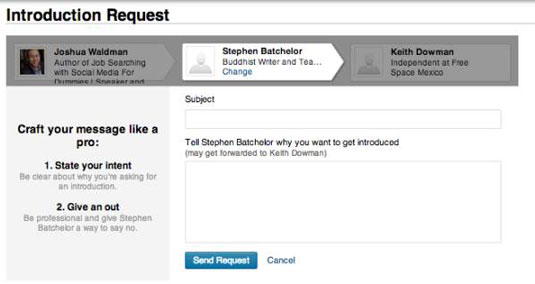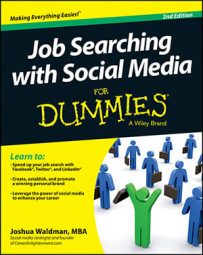When using LinkedIn to make your first contact with a hiring manager during your job search (and chances are you’ll use LinkedIn to do this), never, ever, ever invite a hiring manager to connect with your network as your first communication.
Many professionals guard their first-degree connections on LinkedIn very carefully. If a stranger comes around looking not only for a job but also for access to their network, they may get defensive. Restrain yourself from connecting with a hiring manager on LinkedIn until after you’ve met in person and you’ve asked whether it’s okay to connect (unless of course the hiring manager indicates something different on her profile).
The best way to contact a hiring manager via LinkedIn is through an introduction. A LinkedIn Introduction has two parts to it: a note to the person you’re targeting and a note to whoever’s introducing you to that person. But if introductions don’t work, you can always try InMail.

If you’ve done a good job conducting informational interviews, then you’ll have met with and made connections with people at your target organization. Adding these folks to your LinkedIn network increases the odds that you’ll become the second- or third-degree contact of your targeted hiring manager, which means you can ask for an introduction to that person through your first-degree contact.
The number of introductions you can request per month is limited depending on your level of subscription on LinkedIn. To ask for an introduction, follow these steps:
Navigate to the profile of the hiring manager you want to speak to.
Click on the Get Introduced link hidden behind the drop-down triangle next to Connect.
If you have more than one common contact, choose the contact most likely to pass on your connection request. Jot down your note to the introducer here.
Include the name of the person introducing you in the Subject line, such as, “Friend of Ian Troducer looking to connect about a potential fit.”
According to Neal Schaffer, a LinkedIn trainer, this approach to introduction subject lines adds credibility to the note and increases the likelihood that the person will respond.
By asking the introducer person to pass on your request, you’re asking her to put her reputation on the line for you, meaning she’s taking on some risk if you monkey things up. So be as respectful as you can of her time and willingness to help.
Pay as much attention to your request for an introduction as you do to your message to the hiring manager. When asking a contact for an introduction, make sure to follow these guidelines:
Tell the introducer why you want to talk to the target person. Reassure your contact that you’re not planning to ask the hiring manager for a job. Instead, you’re simply exploring the possibility of a fit between you and the hiring manager’s employer. Say how this introduction will help you with your professional goals.
Specify what the conversation will be about. Share the types of questions you plan to ask. Reassure the introducer that you won’t pester her contact.
Offer to answer additional questions about yourself and your intentions on the phone with the introducer. It helps to throw this option out there, but leave the final decision up to your contact. Don’t start calling her every day to find out whether she’s passed your introduction along. Just one call or reminder e-mail is sufficient.
Show appreciation for the impact this person may have on your career. Be professionally assertive, not casually apologetic. Say something like, “I would very much appreciate it if you would…”
Here’s an example of a note you may send to a contact asking for an introduction:
Hi [name of your contact],
I am interested in setting up an informational interview with [name of hiring manager], one of your connections on LinkedIn.
I want to ask her about open positions she may have at [target company] and see if I may be a fit for the organization.
If you are more comfortable passing on this introduction after a phone call, I am happy to chat with you about my intentions. You can decide whether to pass my name on from there.
Otherwise, I would very much appreciate it if you would forward my message to [name of hiring manager].
Thanks for your help,
[your name]
If you’re networking the way you should, which is a lot, then you may have many outstanding introduction requests. Keep track of them in a spreadsheet. If, after a reminder to your introducer, you are still not connected, withdraw your introduction request and find someone else to connect you to your target. Give the introducer ten days to act or not before moving on.
After you’ve been introduced, the onus is on you to take the next step. But proceed carefully. Because you’re not yet sure of your fit with the organization and, in some cases, you may not even know whether a position is open, don’t be overconfident in your message to the hiring manager.
Hiring managers are often turned off by candidates who insist they’re perfect for an organization even though they haven’t asked any questions yet. So instead of making this faux pas, be clear that you’re just looking to explore the possibility of a fit. After all, thinking you’re a fit and admitting that you’re curious to find out whether that’s true is perfectly okay.

